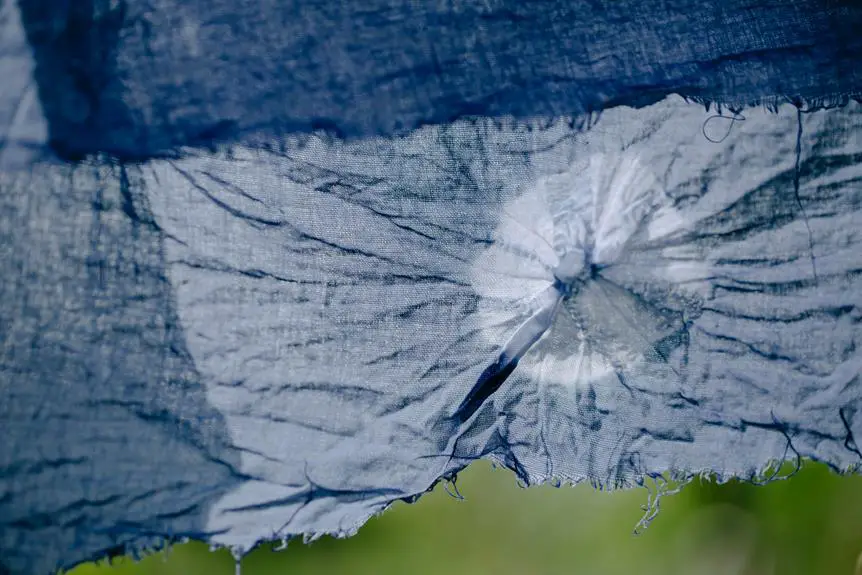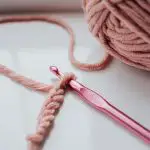Looking to add some vibrant flair to your fabric? Tie dye has been around for centuries, with the earliest known examples dating back to around 6,000 years ago in Peru.
These 5 must-try tie dye patterns for fabric will take your DIY projects to the next level. Whether you're a seasoned tie dye enthusiast or just starting out, mastering these patterns will give your creations a professional edge.
From the classic bullseye to the trendy ombre, these techniques offer endless possibilities for customizing your fabric.
Get ready to elevate your tie dye game and impress everyone with your mastery of these eye-catching patterns.
Key Takeaways
- The bullseye tie dye pattern involves folding fabric in a concentric manner to create concentric circles.
- The spiral tie dye pattern is created by twisting fabric in a clockwise motion and securing it with rubber bands.
- The crumple tie dye pattern is achieved by crumpling fabric into a ball and securing it with rubber bands.
- The ombre tie dye pattern requires attention to detail and practice to achieve the desired effect.
Bullseye Tie Dye Pattern
When creating the Bullseye tie dye pattern, start by folding the fabric in a concentric manner to achieve the desired design. This technique involves folding the fabric in a way that creates a series of concentric circles, similar to the rings of a bullseye.
Once the fabric is folded, apply your chosen color combinations. For a traditional bullseye pattern, you might opt for a single color for the outermost circle, followed by a different color for the next circle, and so on, until you reach the center. This creates a visually striking effect that's synonymous with the bullseye pattern.
To achieve more intricate designs, you can experiment with different folding and binding techniques. For example, try pleating the fabric before applying the dye, or using rubber bands to create sections within each circle. These variations can result in stunning and unique bullseye patterns.
It's important to remember that the way you fold and bind the fabric will directly impact the final design, so take your time to explore different techniques and find the combination that works best for your desired outcome.
Mastering the bullseye tie dye pattern involves a combination of precision, creativity, and an understanding of various tie dye fabric techniques.
Spiral Tie Dye Pattern
To achieve a captivating spiral tie dye pattern on fabric, gather your materials and prepare a flat work surface. Start by soaking the fabric in a solution of water and soda ash to ensure the dye adheres properly. Once the fabric is ready, lay it flat and pinch the center of the fabric with your fingers. Begin twisting the fabric in a clockwise motion, creating a spiral shape. Secure the twisted fabric with rubber bands, dividing it into triangular sections to create a stunning spiral pattern. Now, it's time to prepare your dye colors. Consider using vibrant color combinations such as blue and green, or yellow and orange to make your spiral pattern pop. Apply the dye to each section of the fabric, making sure to saturate it thoroughly. After dyeing, place the fabric in a plastic bag to keep it damp, allowing the dye to set for 6-8 hours. Once the dye has set, rinse the fabric until the water runs clear, then remove the rubber bands and admire your mesmerizing spiral tie dye creation.
| Color Combinations | Fabric Preparation |
|---|---|
| Blue and Green | Soak fabric in water and soda ash |
| Yellow and Orange | Twist fabric into a spiral shape |
Crumple Tie Dye Pattern
Once you have gathered your materials and prepared a flat work surface, crumple the fabric to begin creating the crumple tie dye pattern. The crumple technique is a popular method in fabric dyeing trends, known for its unique and organic-looking results. Here's how to achieve this eye-catching pattern:
- Crumple the Fabric: Lay the fabric flat, then pinch and twist it into a crumpled ball. The more random and varied the crumpling, the more interesting the final pattern will be.
- Secure with Rubber Bands: Use rubber bands to secure the crumpled fabric. This will help maintain the crumpled shape and create defined white spaces within the pattern.
- Apply the Dye: With the crumpled fabric secured, apply the fabric dye in your chosen colors. Ensure that the dye penetrates the entire fabric, including the creases and folds.
- Let it Set: Once the fabric is fully dyed, place it in a plastic bag or wrap it in plastic wrap to keep it moist. Let the dye set for the recommended time before rinsing and revealing your stunning crumple tie dye pattern.
Experiment with different color combinations and fabric types to create your own unique crumple tie dye designs.
Ombre Tie Dye Pattern
To create an ombre tie dye pattern, start by smoothly transitioning colors from the crumpled fabric, resulting in a beautiful gradient effect. Choosing the right fabric for ombre dyeing is crucial. Fabrics like cotton, linen, and rayon work well due to their ability to absorb and hold dye.
Tips for achieving perfect ombre effects include pre-washing the fabric to remove any sizing, which can interfere with dye absorption. Additionally, ensure the fabric is damp before dyeing to help the colors blend seamlessly.
For a striking ombre effect, mix different dye concentrations to create a range of tones. Start with the lightest color at one end of the fabric and gradually transition to the darkest shade at the other end. The key is to work quickly and methodically, blending the colors together to avoid harsh lines.
Experiment with different folding and tying techniques to create unique patterns within the ombre design. With attention to detail and practice, mastering the ombre tie dye pattern can result in stunning, professional-looking fabric creations.
Striped Tie Dye Pattern
Explore creating a striped tie dye pattern by alternating sections of the fabric to achieve a bold and eye-catching design. Remember to select the appropriate fabric for tie dyeing to ensure vibrant and long-lasting colors.
When creating a striped tie dye pattern, consider the following:
- Color Combination: Choose complementary or contrasting colors to create a visually appealing striped design. Experiment with different color combinations to achieve the desired effect. For example, pairing deep blue with bright yellow can create a striking contrast that pops.
- Fabric Materials: Opt for natural fibers like cotton or linen, as they absorb the dye well and result in vibrant colors. The fabric's absorbency and texture play a significant role in how the dye will spread and blend, affecting the final look of the stripes.
- Section Width: Experiment with different section widths to achieve varying stripe thicknesses. Wider sections create bold, prominent stripes, while thinner sections result in a more delicate, intricate pattern.
- Dye Application: To achieve crisp, clean lines, carefully apply the dye to each section, ensuring that the colors don't bleed into each other.
Frequently Asked Questions
Can Tie Dye Patterns Be Created on Different Types of Fabric, Such as Silk or Velvet?
Yes, tie dye patterns can be created on different types of fabric, such as silk or velvet. You can use specific tie dye techniques to achieve vibrant designs while considering preservation and safety precautions.
Are There Any Special Techniques or Tools Required to Achieve a Specific Tie Dye Pattern, Like the Bullseye or Ombre?
To achieve a specific tie dye pattern, special techniques and tools are essential. For the bullseye pattern, you'll need to master the art of folding and binding, while achieving the ombre effect requires precise dye application and blending.
How Can Tie Dye Patterns Be Preserved and Maintained After the Fabric Has Been Dyed?
To preserve and maintain tie dye, rinse the fabric in cold water until the water runs clear. Wash separately in cold water with a gentle detergent. Avoid direct sunlight and heat when drying to prevent fading.
Can Tie Dye Patterns Be Combined or Overlapped to Create Unique Designs, Such as Incorporating Both the Spiral and Crumple Patterns?
Yes, you can combine tie dye patterns to create unique designs. Overlap techniques like incorporating both spiral and crumple patterns can result in one-of-a-kind fabric customization. Experiment with different combinations to achieve stunning results.
Are There Any Safety Considerations or Precautions to Keep in Mind When Working With Tie Dye Materials, Such as the Dyes or Chemicals Used in the Process?
When working with tie dye materials, it's crucial to prioritize safety precautions. Proper chemical handling, health considerations, and dye disposal are essential. Always use protective gear, work in a well-ventilated area, and follow instructions meticulously.
- How Does Ring Spun Cotton Affect Garment Fit and Shape Retention? - August 13, 2024
- What Are the Challenges in Producing Ring Spun Cotton? - August 13, 2024
- Is Ring Spun Cotton Suitable for Plus-Size Clothing? - August 13, 2024





